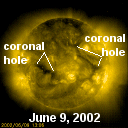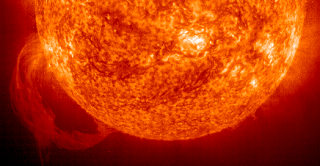|   SPACE WEATHER SPACE WEATHER
Current
Conditions
Solar Wind
speed: 401.4 km/s
density:5.0 protons/cm3
explanation | more data
Updated: Today at 2256 UT
X-ray Solar Flares
6-hr max: C1 2155 UT Jun10
24-hr: C1 1025 UT Jun10
explanation | more data
Updated: Today at 2245 UT
Daily Sun: 10 June '02 
The Sun is peppered with spots, but none pose a threat for strong flares. Image credit: SOHO/MDI
The Far Side of the Sun

This holographic image reveals no large spots on the far side of the Sun. Image credit: SOHO/MDI
Sunspot Number: 180
More about sunspots
Updated: 09 Jun 2002
Interplanetary Mag. Field
Btotal: 6.6 nT
Bz: 3.4 nT north
explanation | more data
Updated: Today at 2257 UT Coronal Holes:

Earth is inside a solar wind stream flowing from the right-most coronal hole. Image credit: SOHO Extreme UV Telescope.
More about coronal holes
Radio Meteor Rate
24 hr max: 29 per hr
Listen to the Meteor Radar!
Updated: 08 June 2002
 SPACE WEATHER SPACE WEATHER
NOAA
Forecasts
Solar Flares: Probabilities for a medium-sized (M-class) or a major (X-class) solar flare during the next 24/48 hours are tabulated below.
Updated at 2002 Jun 10 2200 UTC
| FLARE | 0-24 hr | 24-48 hr | | CLASS M | 25 % | 25 % | | CLASS X | 01 % | 01 % |
Geomagnetic Storms: Probabilities for significant disturbances in Earth's magnetic field are given for three activity levels: active, minor storm, severe storm
Updated at 2002 Jun 10 2200 UTC Mid-latitudes | 0-24 hr | 24-48 hr | | ACTIVE | 10 % | 10 % | | MINOR | 01 % | 01 % | | SEVERE | 01 % | 01 % |
High latitudes | 0-24 hr | 24-48 hr | | ACTIVE | 20 % | 15 % | | MINOR | 05 % | 05 % | | SEVERE | 01 % | 01 % |

Web server provided by
VPS Hosting | What's Up in Space -- 10 Jun 2002
Subscribe to Space Weather News!  SUNSET ECLIPSE: Don't miss it on Monday: a partial solar eclipse. Across much of North America the setting Sun will become a strange-looking crescent when the Moon glides in front of our star. Read the full story from Science@NASA. SUNSET ECLIPSE: Don't miss it on Monday: a partial solar eclipse. Across much of North America the setting Sun will become a strange-looking crescent when the Moon glides in front of our star. Read the full story from Science@NASA.
WARNING: Never stare at the Sun! Sunlight can blind you even during an eclipse. Click here for safe observing tips. SOLAR BLAST: An enormous magnetic loop filled with glowing-hot gas lifted off the Sun on June 9th. Astronomers call such events "prominences" -- they're caused by explosive instabilities within the Sun's tangled magnetic field. This one stretches about 50 Earth-diameters from one end to the other.  Above: An ultraviolet telescope onboard the Solar and Heliospheric Observatory captured this spectacular view of the prominence at 13:19 UT on June 9th. JUPITER AND THE MOON: Step outside just after sunset on Wednesday, June 12th, and look west. The planet Jupiter and the slender cresent Moon will appear side-by-side -- a lovely sight. While you're there, check out the ghostly glow of Earthshine across the Moon's dark terrain! [gallery] [finder chart] WEB LINKS: NOAA FORECAST | GLOSSARY | SPACE WEATHER TUTORIAL | LESSON PLANS | BECOME A SUBSCRIBER | 
Potentially Hazardous Asteroids (PHAs) are space rocks larger than approximately 100m that can come closer to Earth than 0.05 AU. None of the known PHAs are on a collision course with our planet, although astronomers are finding new ones all the time.
On 10 Jun 2002 there were 438 known Potentially
Hazardous Asteroids June 2002 Earth-asteroid encountersNotes: LD is a "Lunar Distance." 1 LD = 384,401 km, the distance between Earth and the Moon. 1 LD also equals 0.00256 AU. MAG is the visual magnitude of the asteroid on the date of closest approach.  - COMET IKEYA-ZHANG: The brightest comet in years delighted sky watchers in March and April 2002. [gallery]
- GONE JUPITER: On Feb. 22, 2002, the Moon had a close encounter with Jupiter. [gallery]
- GONE SATURN: On Feb. 20, 2002, the Moon glided in front of Saturn and its mysterious rings. [gallery]
- HOT COMET: Periodic comet 96P/Machholz put on a dazzling show as it swung by the Sun on Jan. 8, 2002.
- ASTEROID FLYBY: Asteroid 2001 YB5 raced past Earth on Jan. 7, 2002, only two times farther away than the Moon. [gallery]
- SUBTLE ECLIPSE: The Moon dipped into the outskirts of Earth's shadow on Dec. 30, 2001. [gallery]
- MOON & SATURN: The Moon keeps getting in the way of Saturn! See the series of close encounters here.
- CHRISTMAS LIGHTS: On Christmas Eve, 2001, a solar wind stream triggered Northern Lights. [gallery]
- SOLAR ECLIPSE: Sky watchers in Hawaii and most parts of North America experienced a partial solar eclipse on Dec. 14th. [gallery]
- BRIGHT ASTEROID: Videos and images of 1998 WT24 -- a big and bright near-Earth asteroid that came close to our planet on Dec. 16, 2001. [gallery]
- NORTHERN LIGHTS: On Nov. 24th a pair of coronal mass ejections swept past Earth and triggered worldwide auroras.
- LEONIDS 2001: Some people saw it. Others heard it. In either case, they'll never forget it: The 2001 Leonid meteor storm.
- PERSEIDS 2001: Perseid watchers on August 12th spotted meteors, auroras, and a disintegrating Russian rocket! [gallery]
- MORNING PLANETS: In July and Aug. 2001, the Moon, Jupiter, Saturn, Venus, and Mercury put on a dazzling early-morning sky show. [gallery]
- ECLIPSE SAFARI: Onlookers cried out in delight on June 21, 2001, when the Moon covered the African Sun, revealing the dazzling corona. [gallery]
- TOTAL LUNAR ECLIPSE: On Jan. 9, 2001, the full Moon glided through Earth's copper-colored shadow. [gallery]
- CHRISTMAS ECLIPSE: Sky watchers across North America enjoyed a partial solar eclipse on Christmas Day 2000 [gallery]
- LEONIDS 2000: Observers around the globe enjoyed three predicted episodes of shooting stars. [gallery]
 Nov. 7 , 2001: What Lies beneath a Sunspot -- Awesome plasma hurricanes were one of the surprises revealed when scientists peered beneath the stormy surface of our star. Nov. 7 , 2001: What Lies beneath a Sunspot -- Awesome plasma hurricanes were one of the surprises revealed when scientists peered beneath the stormy surface of our star. Oct. 26 , 2001: 'tis the Season for Auroras -- Autumn is a good time to spot Northern Lights. Oct. 17, 2001: Halley's Comet Returns ... in bits and pieces -- The annual Orionid meteor shower peaks on October 21st. Aug. 9, 2001: Horse Flies and Meteors -- Like bugs streaking down the side window of a moving car, long and colorful Perseid Earthgrazers could put on a remarkable show on August 11th. July 27, 2001: Meteorites Don't Pop Corn -- A fireball that dazzled Americans on July 23rd probably didn't scorch any cornfields, contrary to widespread reports. June 12, 2001: The Biggest Explosions in the Solar System -- NASA's HESSI spacecraft aims to unravel an explosive mystery: the origin of solar flares. |

